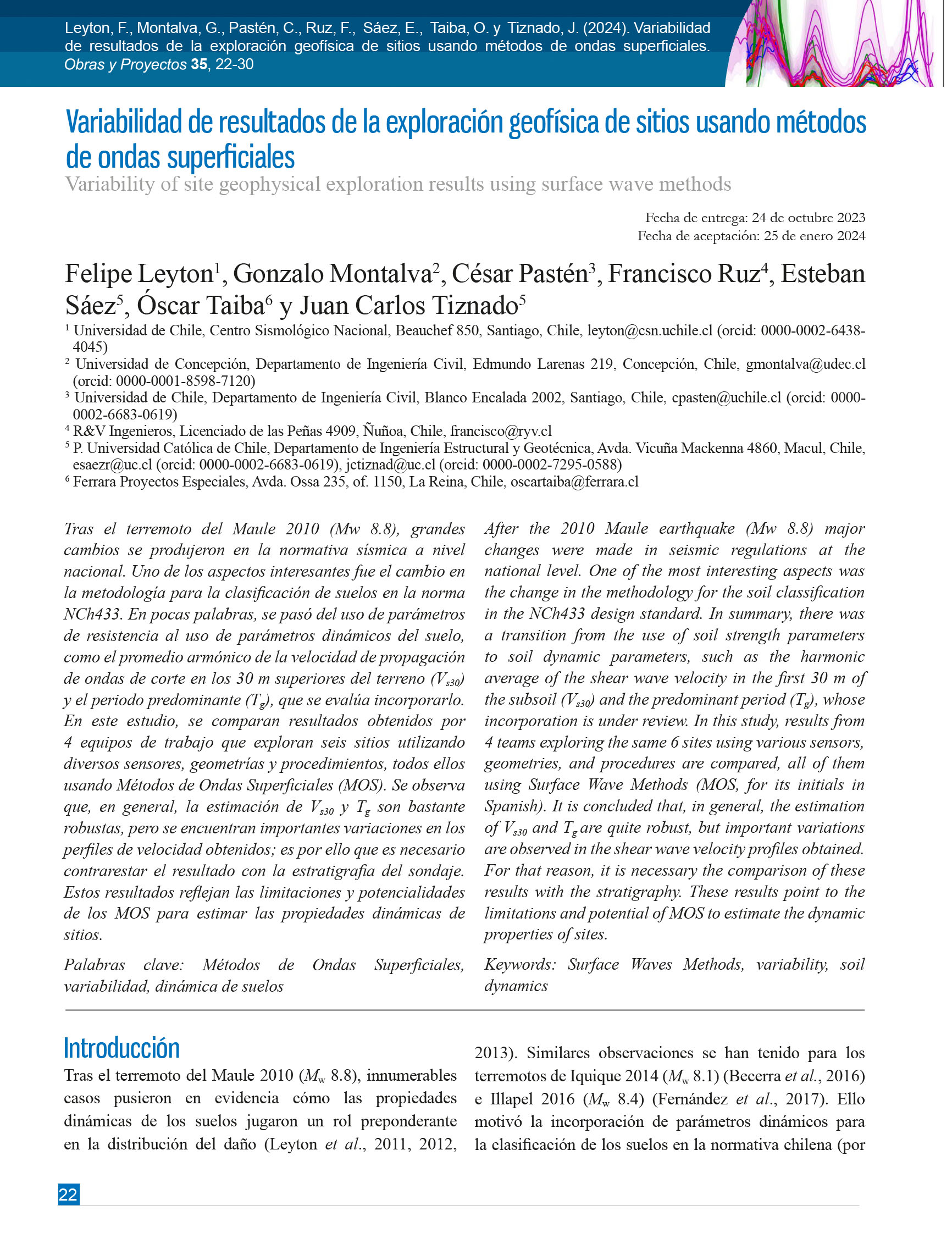Variabilidad de resultados de la exploración geofísica de sitios usando métodos de ondas superficiales
DOI:
https://doi.org/10.21703/0718-2813.2024.35.2796Palabras clave:
Métodos de Ondas Superficiales, Variabilidad, Dinámica de suelosResumen
Tras el terremoto del Maule 2010 (Mw 8.8), grandes cambios se produjeron en la normativa sísmica a nivel nacional. Uno de los aspectos interesantes fue el cambio en la metodología para la clasificación de suelos en la norma NCh433. En pocas palabras, se pasó del uso de parámetros de resistencia al uso de parámetros dinámicos del suelo, como el promedio armónico de la velocidad de propagación de ondas de corte en los 30 m superiores del terreno (Vs30) y el periodo predominante (Tg), que se evalúa incorporarlo. En este estudio, se comparan resultados obtenidos por 4 equipos de trabajo que exploran seis sitios utilizando diversos sensores, geometrías y procedimientos, todos ellos usando Métodos de Ondas Superficiales (MOS). Se observa que, en general, la estimación de Vs30 y Tg son bastante robustas, pero se encuentran importantes variaciones en los perfiles de velocidad obtenidos; es por ello que es necesario contrarestar el resultado con la estratigrafia del sondaje. Estos resultados reflejan las limitaciones y potencialidades de los MOS para estimar las propiedades dinámicas de sitios.
Referencias
Aki, K. (1957). Space and time spectra of stationary stochastic waves, with special reference to microtremors. Bulletin of Earthquake Research Institute 35, 415–456.
Asten, M.W. and Henstridge, J.D. (1984). Array estimators and the use of microseisms for reconnaissance of sedimentary basins. Geophysics 49(11), 1828-1837.
Becerra, A., Sáez, E., Podestá, L. and Leyton, F. (2016). The 2014 earthquake in Iquique, Chile: Comparison between local soil conditions and observed damage in the cities of Iquique and Alto Hospicio. Earthquake Spectra 32(3), 1489-1505.
Becerra, A., Podestá, L., Monetta, R., Sáez, E., Leyton, F. and Yañez, G. (2015). Seismic microzoning of Arica and Iquique, Chile. Natural Hazards 79, 567-586.
Chávez-García, F.J., Rodríguez, M. and Stephenson, W.R. (2005). An alternative approach to the SPAC analysis of microtremors: exploiting stationarity of noise. Bulletin of the Seismological Society of America 95(1), 277-293.
Chávez-García, F.J., Rodríguez, M. and Stephenson, W.R. (2006). Subsoil structure using SPAC measurements along a line. Bulletin of the Seismological Society of America 96(2), 729-736.
Ekström, G. (2014). Love and Rayleigh phase-velocity maps, 5–40 s, of the Western and Central USA from USArray data. Earth and Planetary Science Letters 402, 42-49.
Ekström, G., Abers, G.A. and Webb, S.C. (2009). Determination of surface‐wave phase velocities across USArray from noise and Aki’s spectral formulation. Geophysical Research Letters 36(18), 5-9.
Fernández, J., Pastén, C., Ruiz, S. y Leyton, F. (2017). Estudio de efectos de sitio en la Región de Coquimbo durante el terremoto de Illapel Mw 8.3 de 2015. Obras y Proyectos 21, 20-28.
Garofalo, F., Foti, S., Hollender, F., Bard, P.Y., Cornou, C., Cox, B.R., Ohrnberger, M., Sicilia, D., Asten, M., di Giulio, G., Forbriger, T., Guillier, B., Hayashi, K., Martin, A., Matsushima, S. Mercerat, D., Poggi, V. and Yamanaka, H. (2016a). InterPACIFIC project: Comparison of invasive and non-invasive methods for seismic site characterization. Part I: Intra-comparison of surface wave methods. Soil Dynamics and Earthquake Engineering 82, 222-240.
Garofalo, F., Foti, S., Hollender, F., Bard, P.Y., Cornou, C., Cox, B.R., Dechamp, A., Ohrnberger, M., Perron, V., Sicilia, D., Teague, D. and Vergniault, C. (2016b). InterPACIFIC project: Comparison of invasive and non-invasive methods for seismic site characterization. Part II: Inter-comparison between surfacewave and borehole methods. Soil Dynamics and Earthquake Engineering 82, 241-254.
Garofalo, F., Foti, S., Hollender, F., Bard, P.Y., Cornou, C., Cox, B.R., Dechamp, A., Ohrnberger, M., Sicilia, D. and Vergniault, C. (2017). Reliability and accuracy assessment of invasive and non-invasive seismic methods for site characterization: feedback from the InterPacific project. 16th World Conference on Earthquake Engineering 16WCEE, ACHISINA, paper 4938, Santiago, Chile.
Hayashi, K. (2008). Development of the surface-wave methods and its application to site investigations. PhD dissertation, Kyoto University, Japan.
Horike, M. (1985). Inversion of phase velocity of long-period microtremors to the S-wave-velocity structure down to the basement in urbanized areas. Journal of Physics of the Earth 33(2), 59-96.
Humire, F., Sáez, E., Leyton, F. and Yañez, G. (2015). Combining active and passive multi-channel analysis of surface waves to improve reliability of VS,30 estimation using standard equipment. Bulletin of Earthquake Engineering 13, 1303-1321.
Konno, K. and Ohmachi, T. (1998). Ground-motion characteristics estimated from spectral ratio between horizontal and vertical components of microtremor. Bulletin of the Seismological Society of America 88(1), 228-241.
Kvaerna, T. and Ringdahl, F. (1986). Stability of various f-k estimation techniques. Semi-annual Technical Summary, Norsar Scientific Report, 29-40.
Leyton, F., Leopold, A., Hurtado, G., Pastén, C., Ruiz, S., Montalva, G. and Saéz, E. (2018). Geophysical characterization of the Chilean seismological stations: First results. Seismological Research Letters 89(2A), 519-525.
Leyton, F., Ruiz, S., Sepúlveda, S.A., Contreras, J.P., Rebolledo, S. and Astroza, M. (2013). Microtremors‘ HVSR and its correlation with surface geology and damage observed after the 2010 Maule earthquake (Mw 8.8) at Talca and Curicó, Central Chile. Engineering Geology 161, 26-33.
Leyton, F., Montalva, G. and Ramírez, P. (2012). A preliminary study of seismic microzonation of Concepción based on microtremors, geology, and damages patterns. Obras y Proyectos 11, 40-46.
Leyton, F., Sepúlveda, S.A., Astroza, M., Rebolledo, S., Acevedo, P., Ruiz, S., González, L. and Foncea, C. (2011). Seismic zonation of the Santiago basin, Chile. 5th International Conference on Earthquake Geotechnical Engineering 5ICEGE, ISSMGE and SOCHIGE, R. Verdugo (ed.), session 5, paper SMSLF, Santiago, Chile.
Nakamura, Y. (1989). A method for dynamic characteristics estimation of subsurface using micro- tremor on the ground surface. Quarterly Report of Railway Technical Research Institute 30, 25–33.
NCh433 (2009). Diseño sísmico de edificios. INN, Santiago, Chile.
NCh2369 (2023). Diseño sísmico de estructuras e instalaciones industriales. INN, Santiago, Chile.
Pastén, C., Sáez, M., Ruiz, S., Leyton, F., Salomón, J. and Poli, P. (2016). Deep characterization of the Santiago Basin using HVSR and cross-correlation of ambient seismic noise. Engineering Geology 201, 57-66.
Podestá, L., Sáez, E., Yáñez, G. and Leyton, F. (2019). Geophysical study and 3-D modeling of site effects in Viña del Mar, Chile. Earthquake Spectra 35(3), 1329-1349.
Sambridge, M. (1999). Geophysical inversion with a neighbourhood algorithm—I. Searching a parameter space. Geophysical Journal International 138(2), 479-494.
Tokimatsu, K. (1997). Geotechnical site characterization using surface waves. 1st International Conference on Earthquake Geotechnical Engineering 3, A. A. Balkema, Rotterdam, the Netherlands, 1333–1368.
Wathelet, M. (2008). An improved neighborhood algorithm: Parameter conditions and dynamic scaling. Geophysical Research Letters 35, L09301.
Wathelet, M., Chatelain, J.L., Cornou, C., Giulio, G.D., Guillier, B., Ohrnberger, M. and Savvaidis, A. (2020). Geopsy: A user‐ friendly open‐source tool set for ambient vibration processing. Seismological Research Letters 91(3), 1878-1889.

Descargas
Publicado
Número
Sección
Licencia

Esta obra está bajo una licencia internacional Creative Commons Atribución-NoComercial 4.0.







